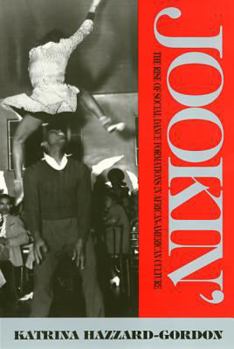Jookin': The Rise of Social Dance Formations in African-American Culture
Select Format
Select Condition 
Book Overview
Katrina Hazzard-Gordon offers the first analysis of the development of the jook--an underground cultural institution created by the black working class--together with other dance arenas in African-American culture. Beginning with the effects of African slaves' middle passage experience on their traditional dances, she traces the unique and virtually autonomous dance culture that developed in the rural South. Like the blues, these secular dance...
Format:Hardcover
Language:English
ISBN:087722613X
ISBN13:9780877226130
Release Date:May 1990
Publisher:Temple University Press
Length:241 Pages
Weight:1.00 lbs.
Dimensions:0.9" x 5.8" x 8.5"
Customer Reviews
1 rating
A good book, but I want to know more about Jookin'
Published by Thriftbooks.com User , 17 years ago
_Jookin'_ is a necessary book if you are on the trail of African American musical and dance culture. Its approach is the acceptance of the integral relationship between music and dance and life among the African peoples enslaved into the current US and its survival and continuation in Black popular dance. There is much in her discussion of this in colonial times particularly that is useful, especially if read along with other more clearly documented texts like Emery's _Black Dance 1619 to Today_. Indeed, Hazzard-Gordon tend's to go back and forth in regard to what period she is talking about with an inconsistency that makes the historically oriented reader a bit confused and disappointed. From the title we expect a full discussion, explanation of the life of the blues juke houses that reigned as centers of African American musical and dance creation and celebration from the post reconstruction period to the end of the agricultural Black belt south in the 1950s and 1960s. Yet Hazzard-Gordon does not stop and dwell upon this phase, but moves forward to a concentration of popular African American entertainment venues in Cleveland, Ohio and their relationship with local politics. For those interested this is an interesting study and brings back aspects of African American life across the country that is rarely documented--urban black popular entertainment in the first half of the 20th century. Whatever the exact differences between the story she tells of Cleveland and other cities, I am sure both in memory and need for study, this segment of the book will be interesting and rewarding to readers. However, this segment reflects problems that the book has all along. Hazzard-Gordon feels the need to provide nearly complete explanations of political and economic factors that have impact on her subject. This is commendable. Yet, these explanations get so large that they sometimes overshadow what she really has to say about Black vernacular dance and entertainment, which is what the book is supposed to be about. Nevertheless, this book is an important achievement as it attempts to capture the essentialness of popular dance and music to African American life and its popular outlets both underslavery and since. Unlike other authors who discuss popular and folk dance only until the development of professional Black entertainment in minstrel shows and the stage, and abandon that once art dancing emerges in the early 20th Century, her focus remains squarely on popular dance from the forced "dancing" on the slave ships to the "dancing in the street" of the urban block parties of the 1950s and 1960s. While this reader might have wanted more about rural Juke Houses, and more about the experience of their urban descendants, her picture of the mixture of business and politics in the growth of urban clubs, bars, dance halls, after hours joints, and night clubs in Cleveland is quite useful to understand African American urban life in t






